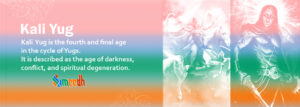Kali Yug is the fourth and final age in the cycle of Yugs, as described in Hindu cosmology. It follows Satya Yug, Treta Yug, and Dvapar Yug. Kali Yug is characterized by a significant decline in righteousness (dharma) and an increase in unrighteousness. It is considered the age of darkness, conflict, and spiritual degeneration.

Kalki is the only avatar of Vishnu that is yet to be born which is mentioned in Srimad Bhagavatam, Vishnu Puran, Mahabharat, Matsya Puran, and Kalki Puran. He will end all evil by defeating the demon Kali and starting a new Satyayuga or Kalkiyuga. Key features and themes associated with Kali Yug include:
- Duration:
- Kali Yug is said to last for 432,000 years, according to the traditional Yug cycle calculations.
- Decline in Virtue:
- Kali Yug is marked by a profound deterioration in moral and spiritual values. Virtue and righteousness diminish, and people become more prone to unethical behavior.
- Spiritual Decline:
- The connection between individuals and the divine weakens. Materialism, greed, and selfishness become prevalent, and spiritual practices decline.
- Conflict and Strife:
- Kali Yug is characterized by an increase in conflict, violence, and societal discord. The prevalence of dishonesty, fraud, and deceit contributes to social unrest.
- Loss of Wisdom:
- Wisdom and knowledge decline, and people become more susceptible to ignorance and delusion. True spiritual understanding becomes rare.
- Shortened Lifespan:
- Human life expectancy decreases in Kali Yug compared to the earlier Yugs. The emphasis on living virtuously and spiritually diminishes.
- Degeneration of Social Institutions:
- Social institutions, including governments and religious organizations, become corrupt and lose their moral authority. The values that once upheld society erode.
- Religious Hypocrisy:
- Religious practices may become more ritualistic and hypocritical, with people following external forms of worship without genuine spiritual understanding.
- Advent of Kalki Avatar:
- According to Hindu prophecy, Kalki, the future tenth avatar of Lord Vishnu, is expected to appear at the end of Kali Yug. Kalki is envisioned as a warrior on a white horse, wielding a sword, who will restore righteousness and bring an end to the age of darkness.
The concept of the Yugs, including Kali Yug, is symbolic and cyclical. It represents the idea that human civilization undergoes repeated cycles of rise and decline. While Kali Yug is characterized by challenges and spiritual degradation, it is also believed to offer opportunities for individuals to seek spiritual growth and redemption amidst the prevailing darkness. The pursuit of virtue, self-discipline, and devotion to the divine are considered means to transcend the challenges of Kali Yug and progress on the path of spiritual evolution.